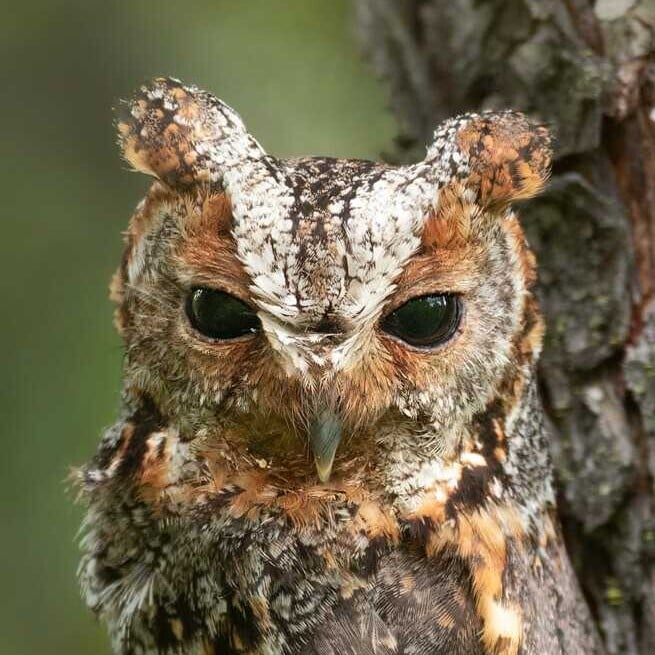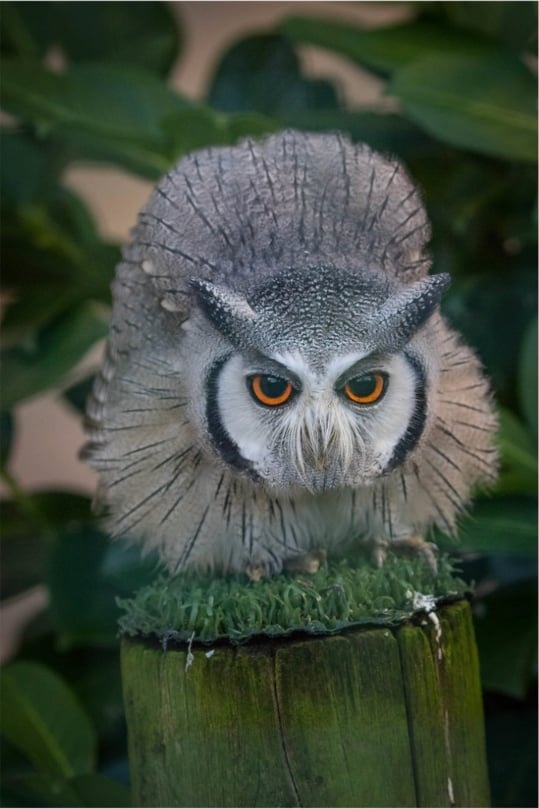From New Mexico Wildlife Center
19 FEB How it started:
One of the patients that came to our hospital last week is a member of a species that has not been admitted to NMWC since 2018: meet Northern Saw-whet Owl 24-40! While 24-40’s species was a bit surprising for us to see, the reason he was admitted is a very common one for owls and other raptors: 24-40 was hit by a car.
24-40 was, however, relatively lucky: he hit the windshield of a vehicle that was traveling slowly, which reduced the severity of his injuries. After the collision, the driver immediately stopped the car to rescue the tiny owl from the road, kept him in a dark and quiet place overnight, then brought him to NMWC the next morning. Careful driving and quick intervention probably helped to give 24-40 an encouraging prognosis! The owl has some bruising on the back of one eye and a mild concussion, but so far he is recovering well.
Vehicle collisions are a common cause of injury for a lot of raptor species and other wildlife. Often, small animals like mice and rats are attracted to discarded food and trash that accumulates on roadsides when people toss things out of car windows. An apple core or piece of bread that gets thrown onto the side of the road might be biodegradable, but it probably wont even have a chance to be broken down before some small animal comes along to snack on it. However, the presence of prey animals close to roads also attracts predators, who are more likely to fly or run into the path of oncoming traffic. One way to protect all wildlife, especially birds of prey, other predators, and scavengers, is to keep roadsides clean and make sure trash finds its way into a trash can or compost bin!
27 FEB What happened:
Northern Saw-whet Owl 24-40 has been released! He flew away so fast that we weren’t able to get it on video, but this small and feisty owl recovered well from his vehicle strike injury and was released right near his rescue location earlier this week. Northern Saw-whet Owls can be found in some parts of New Mexico, primarily at higher elevations, year-round, although throughout much of the United States they are a migratory species and spend the winters farther south before flying back up to northern latitudes to breed in the spring. They can be very difficult to spot in the wild, thanks to their very small stature (24-40 weighed about as much as two golf balls) and excellent camouflage. Northern Saw-whet Owls typically live in forested areas away from a lot of human traffic, which sounds like a great place to be if you want to stay hidden and eat a lot of mice!



Yay! “He flew away so fast that we weren’t able to get it on video” 😂Always good to hear the success stories.
Yup, very glad to see it recovered so quickly!
Here’s a Saw Whet doing some flight rehab at The Raptor Center if you want to see one zipping back and forth.
There have been a bunch of posts lately about raptors consuming poisoned rodents, so I needed an uplifting story. Many raptor groups are trying to get regulations tightened on poison and it’s been hard so far. One rescue just did a survey of their patients, and it was something like almost 70 out of 80 patients so far had signs of ingesting poisoned rodents.
I’m glad they’re working so hard on it, but it makes it hard to look at the feeds sometimes when there is a surge of bad news.
Thanks for posting the video. It’s nice to see one in action. Poor owl’s like “stop walking back and forth! I’m trying to relax!” How do they catch it when they need to put the owl back in its enclosure?
Great question!
I couldn’t find any answer from Google, and I know the handler at the park near me said the Screech has never eaten in front of her after years of being there, so I suppose they’re not always trusting enough to take food as motivation to cooperate.
I sent them an email asking, so I’ll let you know when I hear back!
Update: The person that got back to me said the lady from that video is out right now, but will be back next week and they’ll pass along our question.
So we have to wait, but we’ll get it straight from the source!
Awesome, I look forward to the answer!
Sorry about the delay to this. I had gotten a follow up eventually with the answer, and I responded with some more questions, but never heard back the second time, so I’ll share with you what I got before I forget!
Thanks for sharing. It’s interesting that they can close off parts of the hallway to make the room smaller and smaller. It seems like it would be very tricky to catch them! The towel thing also works on cats that are agitated.
The towel only made my cats angrier!
I’d take my chances with the owl.